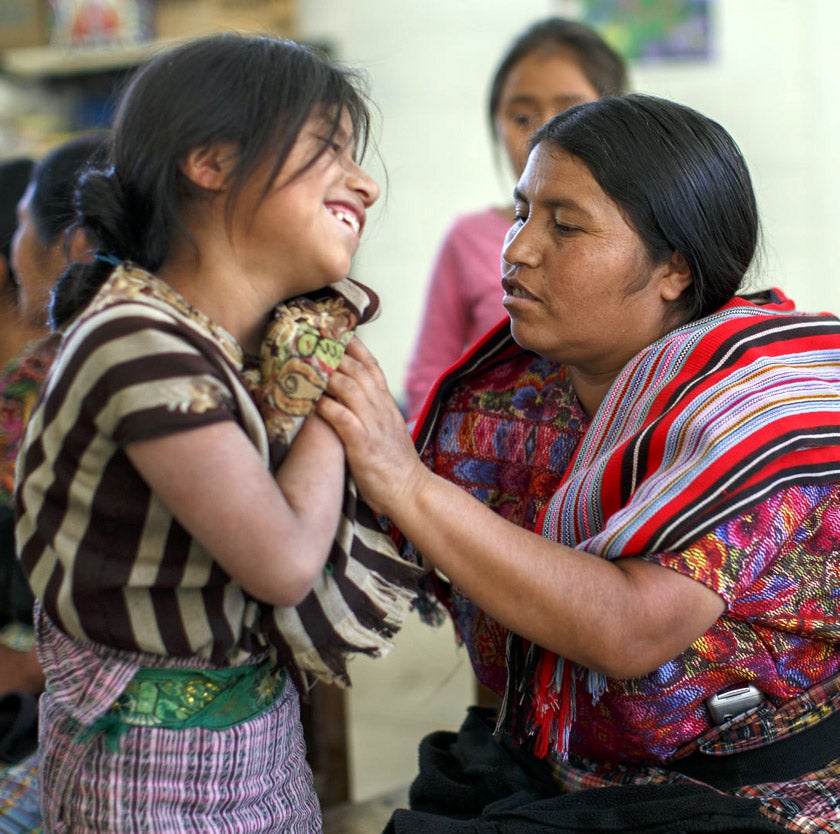
Summary
Since the Elimination Initiative’s launch, PAHO and Member States have documented challenges, lessons, and effective strategies. Sustaining progress requires a multifaceted approach. By focusing on community engagement, addressing social and environmental determinants of health, and tailoring interventions to local contexts, disease elimination programs can more effectively reach and benefit all individuals. By combining resources and addressing multiple diseases through a systems lens, this approach seeks to achieve sustainable disease elimination goals while promoting equity in service delivery and paving the way for a fairer, healthier world for all. PAHO and Member States can apply the lessons learned from the Elimination Initiative to continue to build resilient health systems that can maintain capacities and effectively respond to emerging diseases and future challenges.
Impact of the Elimination Initiative
While the Region of the Americas has achieved remarkable milestones in disease elimination over the past several decades, challenges persist, particularly due to setbacks caused by COVID-19. The Region can build on past successes using available tools and strategies, including universal vaccination programs, point-of-care and rapid tests, and integrated service packages like the Elimination of Motherto- Child Transmission Plus initiative. Reaching elimination targets requires implementing mass drug administration for neglected infectious diseases, integrated actions to reduce morbidity and disability, and innovative solutions for vector-borne diseases. Advanced technologies like portable X rays with artificial intelligence, telemedicine, and multi-disease surveillance and diagnostic platforms can enhance resource efficiency and improve integrated services. The Elimination Initiative helps synergize these resources and strategies across disease programs, fostering collaboration at local and national levels to address communicable diseases with the greatest impact.
 Investing in disease elimination boosts the wellbeing of individuals, communities, nations, and economies. Interventions to fight neglected infectious diseases are highly cost-effective, yielding a net benefit of around USD 25 for every USD 1 invested, resulting in a 30% annualized rate of return (1). The worldwide socioeconomic benefit of eliminating diseases such as leprosy, leishmaniasis, and Chagas disease has been estimated as high as USD 16.6 billion for 2021–2030, with an additional USD 10.4 billion reduction in out-ofpocket expenses (2). Estimated returns for each USD 1 invested in tuberculosis diagnosis and treatment range from USD 30 to USD 115, and fighting the HIV epidemic could avoid USD 24 billion in HIV treatment costs by 2030 and yield a 15-fold return on countries’ HIV investments (3, 4). Every dollar invested in vaccination delivers a return on investment of USD 26.35 (5).
Investing in disease elimination boosts the wellbeing of individuals, communities, nations, and economies. Interventions to fight neglected infectious diseases are highly cost-effective, yielding a net benefit of around USD 25 for every USD 1 invested, resulting in a 30% annualized rate of return (1). The worldwide socioeconomic benefit of eliminating diseases such as leprosy, leishmaniasis, and Chagas disease has been estimated as high as USD 16.6 billion for 2021–2030, with an additional USD 10.4 billion reduction in out-ofpocket expenses (2). Estimated returns for each USD 1 invested in tuberculosis diagnosis and treatment range from USD 30 to USD 115, and fighting the HIV epidemic could avoid USD 24 billion in HIV treatment costs by 2030 and yield a 15-fold return on countries’ HIV investments (3, 4). Every dollar invested in vaccination delivers a return on investment of USD 26.35 (5).
The Elimination Initiative serves as a critical call to action for countries to tackle communicable diseases which most impact their populations. Harnessing regional expertise, driving advocacy and communication at the highest levels, and forging robust partnerships – including public–private collaborations and community engagement – can make a significant impact. Collaboration across borders is a vital path toward addressing shared challenges, building strategic alliances with donors, integrating elimination efforts into primary health care, and enhancing synergy among various programs. Leveraging proven tools and strategies will be crucial to achieving and sustaining the elimination targets. Now is the time to join efforts to fight against communicable diseases.
Key Challenges
PAHO and Member States have identified challenges that must be addressed to maximize the potential of the initiative. These challenges are presented below.
Funding and resource constraints
Funding and resource constraints Funding for health care is already stretched thin, and in the context of noncommunicable diseases, climate change, and other emerging health needs, communicable disease budgets are often insufficient. Another challenge has been implementing the Elimination Initiative within health systems that are organized around individual diseases, with separate program budgets for each disease. Fragmented, siloed funding reduces efficiency by causing duplication of efforts, poor coordination, administrative burdens, fragmented patient care, and reduced flexibility in responding to changing health needs. This approach hinders the system’s ability to provide comprehensive, cost-effective care and respond to public health challenges.
Health inequities
Unequal distribution of healthcare resources allows diseases to persist in underserved communities, creating reservoirs that hinder progress. Limited access to healthcare services reduces the effectiveness of prevention and treatment interventions among marginalized groups, while also delaying detection and response to outbreaks. Stigma and discrimination can also deter individuals from seeking testing and treatment. These disparities result in incomplete coverage of elimination strategies and exacerbate socioeconomic factors that perpetuate disease transmission. Collectively, these issues diminish the impact of elimination efforts.
Maintaining elimination
The Elimination Initiative is not just about achieving elimination but maintaining past gains. However, advocating for sustained efforts (for example, vaccines) can be challenging when public perception of disease risk is low. Constant monitoring is needed to minimize the threat of reintroduction. For example, while the Region has maintained elimination of rubella and congenital rubella, it temporarily lost measles elimination certification during 2013–2015 due to outbreaks in Brazil and the Bolivarian Republic of Venezuela. Integrating elimination efforts into broader health systems, rather than relying on disease-specific programs, could secure long-term commitments. Embedding elimination goals into general health initiatives can create a resilient framework to support ongoing vigilance and response capabilities.
Multisectoral engagement for all 30+ diseases and conditions
While country leaders have committed to the Elimination Initiative, engaging local stakeholders for a multi-disease approach is complex. For example, there is a long history of civil society advocacy within the HIV space, along with other well-known diseases like malaria and tuberculosis. However, this advocacy has been traditionally focused on individual diseases, including social determinants of those most at risk. Encouraging advocates to expand to other diseases – for example, neglected and zoonotic diseases – in this context can be challenging.
Technology and innovation challenges
Disease elimination in the Americas faces significant technological challenges, including inadequate needs-driven research and development and access to health technologies, such as those needed for disease surveillance, diagnostics, and treatment. In addition, although advances in digital health are promising, data integration difficulties and interoperability issues in health information systems remain. Service delivery is hampered by limited diagnostic and surveillance capabilities (especially in remote areas), unintegrated public health laboratory systems, antimicrobial resistance, and gaps in telemedicine infrastructure. The Region also struggles with implementing artificial intelligence and machine learning in health care. Logistical and supply chain management issues persist, including forecasting problems and challenges in storage and distribution. Additionally, many essential health technologies are either not widely available or are unaffordable for broad use.
Migration
Migration within the Americas is driven by economic disparities, political instability, violence, and environmental issues, creating diverse movement patterns within and between countries. This poses challenges for managing communicable diseases by enabling crossborder transmission and disrupting ongoing treatments. Migrants often face limited access to health care, leading to vaccination gaps and increased transmission risks due to living conditions in transit or temporary settlements. Effective surveillance among migrant communities remains difficult. Climate change impacts, cultural and language barriers, strained health systems, and legal status issues further complicate infectious disease control efforts. These interconnected factors collectively impact public health management in both origin and destination areas.
Accelerating the Agenda
PAHO and Member States have identified the following ways to ensure progress continues towards the goals outlined for 2030.
Advocate for continued political and financial support
The Elimination Initiative itself offers a shared vision to the Region. Member States have successfully used this platform to advocate for broad support among government institutions and multisectoral partners, but more remains to be done. Since its 2023 relaunch, momentum has been restored. Continued promotion of the initiative’s ambitious goals is crucial for securing additional support. Advocates can apply lessons from the COVID-19 pandemic to underscore the importance of disease elimination and health system strengthening. Additionally, the Regional Revolving Funds help ensure access to high-quality, affordable health technologies.
Strengthen community engagement
To address Elimination Initiative implementation challenges, PAHO and Member States must integrate communities and civil society into all aspects of communicable disease programs. This engagement ensures strategies are locally relevant and supported. Communities can provide insights on cultural stigmas, reasons for underutilization of certain programs (for example, vaccines), and ideas to boost participation. Capacity building for local teams is essential to effectively gather and incorporate community-level information into broader health strategies.
Improve intercultural services
Social and environmental factors greatly influence disease transmission, requiring strategies that address root causes of health disparities. Prioritizing marginalized communities is key, requiring a nuanced understanding of health equity. Developing culturally relevant services, addressing issues like vaccine hesitancy, addressing cross-border and migrant populations, and incorporating traditional medicine where appropriate ensures that health services are more accessible and acceptable to diverse communities. Strategies must be tailored for location, requiring adaptations to address vulnerabilities in various settings, such as slums or favelas.
Strengthen Primary Health Care strategy implementation
Adopting a primary health care (PHC) approach can accelerate progress toward disease elimination through integrated health services, emphasizing the first level of care and public health functions, multisectoral policy and action, and empowering people and communities. The first level of care is the most effective way to provide access to disease prevention, early detection, and treatment. It may help improve community-level access to health interventions, extend services to underserved areas, and eliminate various diseases simultaneously. The PHC strategy strengthens the entire health system – improving testing and tracing of diseases, medication supply management, data systems, and referral systems, among others.
Work with partners across departments and sectors
The Elimination Initiative is not an isolated effort by specialized teams but a comprehensive approach requiring expertise from diverse fields and partners. In addition to nongovernmental sectors, eliminating diseases also requires multiple government institutions to work together at the national and subnational levels. This can present challenges, as health issues are typically seen as the sole responsibility of the Ministry of Health or local health authorities. However, elevating the elimination agenda to the highest governmental level can ensure broader commitment from additional government institutions like ministries of finance, trade, and industry.  Engaging governors and mayors is critical to empowering intergovernmental response to address the needs of the affected populations in their context. Innovative approaches, such as enhancing regional production of supplies, necessitate collaboration with the private sector, additional government ministries, and trade partners. Leveraging existing strategies such as engaging health communities and health municipalities is critical to reinforce governance, leadership, and stewardship at the local level. When the initiative is truly owned by all of these institutions – incorporated into their strategies and agendas and building from the bottom up – then disease elimination priorities truly become the priorities of the entire Region.
Engaging governors and mayors is critical to empowering intergovernmental response to address the needs of the affected populations in their context. Innovative approaches, such as enhancing regional production of supplies, necessitate collaboration with the private sector, additional government ministries, and trade partners. Leveraging existing strategies such as engaging health communities and health municipalities is critical to reinforce governance, leadership, and stewardship at the local level. When the initiative is truly owned by all of these institutions – incorporated into their strategies and agendas and building from the bottom up – then disease elimination priorities truly become the priorities of the entire Region.
Digital transformation of the health sector
Embracing digital transformation is crucial for increasing the initiative’s impact. PAHO and Member States must leverage digital tools to enhance disease programs’ efficiency and reach. This includes implementing interoperable health information systems, telehealth platforms, and mobile applications to improve data collection, patient tracking, and service delivery, especially in hard-to-reach areas. Investing in digital health infrastructure and building healthcare workers’ capacity to use these tools effectively will strengthen decisionmaking and improve health outcomes through better data collection, analysis, and action. Digital tools can also enhance community networks, making public health messages, services, and prevention efforts more accessible, even in remote or underserved populations.
Ensure access to new technology
PAHO and Member States can advance elimination efforts by promoting the use of innovations at the first level of care and addressing inequities that affect access to technologies. Key technological advancements include enhanced real-time digital surveillance systems, improved diagnostics with rapid tests and multi-disease platforms, advanced vector control (for example, gene drives; messenger RNA [mRNA]), expanded telemedicine, self-care techniques for early screening and treatment, and virtual reality for healthcare worker training. These technologies can improve tracking, diagnosis, treatment, and healthcare delivery across the Americas.
Box 7. South–South cooperation in the Americas: the power of Pan- Americanism
A spirit of Pan-Americanism has fostered robust cooperation in public health across the Americas. This approach recognizes that progress for one nation often benefits all, particularly in combating neglected infectious diseases that pose regional risks. Countries have leveraged mutual support, resource sharing, and knowledge exchange to address health challenges and strengthen solidarity.
South–South partnerships often involve knowledge transfer, capacity building, and direct assistance, often focusing on cross-border cooperation. They contribute to overall health system strengthening, with countries applying their experiences to new challenges. South–South cooperation in disease control has gained momentum, with examples including:
- For several years, malaria-endemic countries have collaborated to establish a system to improve performance and competence in malaria microscopy in the Region, based on the strengths of reference laboratories and on networking principles;
- Mexico supports the HIV drug resistance national surveys providing technical assistance and covering the costs of sample transportation and processing for HIV genotyping;
- Brazil provides training and technical support and donations of antiretroviral drugs to several South American countries;
- Cuba has trained many medical professionals from the Region and has sent medical professionals to support health initiatives in various countries.
PAHO and the Elimination Initiative serve as platforms for countries still working towards disease elimination, facilitating learning and access to support. This approach ensures progress towards more robust health systems across the Americas.
 Creating more resilient health systems and mitigating future disease threats
Creating more resilient health systems and mitigating future disease threats
Despite setbacks caused by the COVID-19 pandemic, the Elimination Initiative continues to drive the development of more integrated, effective, efficient, and equitable health services across the Americas, aimed at accelerating multi-disease elimination. To ensure the continuation of highlevel political and financial commitments, Member States can adopt a multisectoral approach that convenes partners beyond the health sector. Using the Elimination Framework as a guide, countries can tailor interventions to specific contexts and communities. The framework can be flexible and adaptable as new challenges and diseases arise.
To strengthen disease preparedness efforts, PAHO and Member States can collaboratively:
- Enhance disease surveillance through data sharing and improved technology;
- Strengthen health systems, focusing on the first level of care;
- Bolster laboratory and diagnostic capacities to promote new and efficient methods;
- Invest in research and development for vaccines, treatments, and diagnostics;
- Develop robust networks for contact tracing, protocols, and communication;
- Invest in environmental health to mitigate climate change impacts on disease spread;
- Scale up One Health activities to address links between animal and human health;
- Prepare communities through drills and education on precautionary measures;
- Invest in education to combat misinformation and improve public health literacy;
- Cooperate cross-regionally to ensure equitable access to resources.
In strengthening health systems to prepare for future needs and outbreaks, PAHO and Member States can apply lessons learned and scale up effective practices. This includes addressing inequities through a community- and person-centered approach that considers social and environmental determinants and promotes strong community engagement. As 2030 approaches, these efforts will also better support the Elimination Initiative overall, while supporting regional collaboration to mitigate future communicable disease threats. If Member States integrate these preparedness strategies into existing health systems, this will ensure sustainable and consistent prioritization of enhanced surveillance, infrastructure, and community preparedness, even beyond crisis situations.
References
- Fitzpatrick C, Nwankwo U, Lenk E, de Vlas SJ, Bundy DAP. An investment case for ending neglected tropical diseases. In Holmes KK, Bertozzi S, Bloom BR, Jah P, editors. Major infectious diseases. 3rd edition. Washington, DC: The International Bank for Reconstruction and Development/The World Bank; 2017. Available from: https://doi.org/10.1596/978-1-4648-0524-0.
- Lenk EJ, Redekop WK, Luyendijk M, Fitzpatrick C, Niessen L, Stolk WA, et al. Socioeconomic benefit to individuals of achieving 2020 targets for four neglected tropical diseases controlled/eliminated by innovative and intensified disease management: human African trypanosomiasis, leprosy, visceral leishmaniasis, Chagas disease. PLoS Negl Trop Dis. 2018;12(3):e0006250. Available from: https://doi.org/10.1371/journal.pntd.0006250.
- The Stop TB Partnership. The paradigm shift: global plan to end TB 2018–2022. Geneva: Stop TB Partnership; 2019. Available from: https://stoptb.org/assets/documents/global/plan/GPR_2018-2022_Digital.pdf.
- Joint United Nations Program on HIV/AIDS. Fast track: ending the AIDS epidemic by 2030. Geneva: UNAIDS; 2014. Available from: https://www.unaids.org/sites/default/files/media_asset/JC2686_WAD2014report_en.pdf.
- Sim SY, Watts E, Constenla D, Brenzel L, Patenaude BN. Return on investment from immunization against 10 pathogens in 94 low- and middle-income countries, 2011-30. Health Aff. 2020;39(8):1343–1353. Available from: https://doi.org/10.1377/hlthaff.2020.00103.




